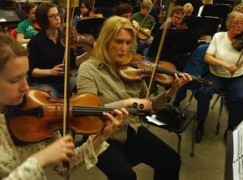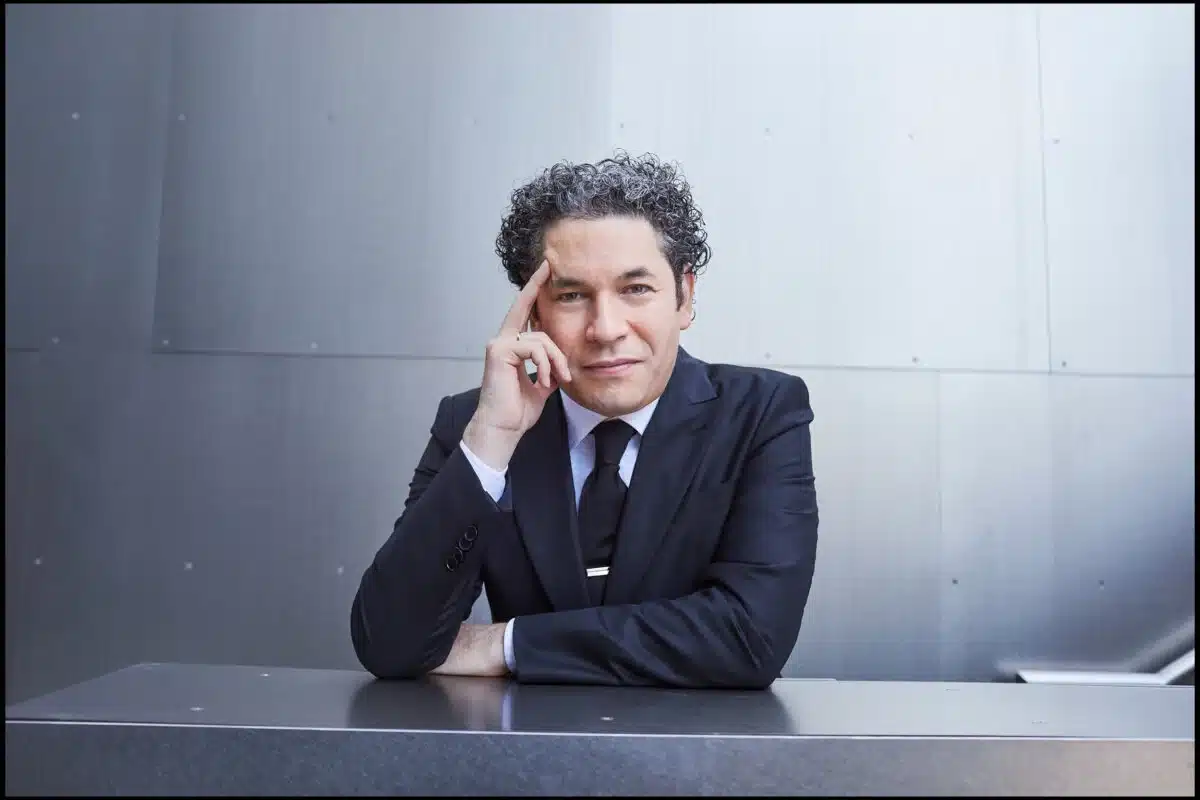Who cares what orchestra women wear?
mainThe NY Philharmonic has got itself into a tangle about what its women should be wearing. Where most orchestras have relaxed the long-dress code, the Philharmonic still refuses to permit pants.
Ladies are required to wear long dresses. It says so in their contract.
Now most reasonable people would expect this to be settled by internal discussion without public involvement. But the New York Times has blown it into a page A1 story:
Bowing to pressure from women who argued that the dress restrictions were not only unfair, but could also hinder their ability to play comfortably, other major orchestras have moved in recent years to let women wear pants if they choose. But gender equality is not the only consideration at the Philharmonic. At a moment when all orchestras are struggling to attract new audiences, some in classical music worry that old-fashioned formal wear can be off-putting to newcomers. So the Philharmonic is also re-examining its rule requiring men to wear white ties and tails, to see if it still makes sense now that the top-hat era has passed…
More than 100 people have seen fit to comment on this.
Go figure.






On this topic, last year I took a friend to a concert and he had not been for many years.
He thought that as the men in the orchestra were all dressed the same then the women should all dress the same as well in the appropriate “uniform” for the orchestra. He thought it was inconsistent to expect the men to dress alike whilst the women were attired in different dresses, tops, skirts or trousers.
I have never given it a thought and don’t mind so long as the orchestra looks well presented.
Women: long pants.
Guys: get out the long dresses.
It’s the only way.
on a more serious note: several surveys have shown, that even young student audiences who attend classical concerts actually LIKE the formal attire.
Keep the white tie dress code. Make it something special.
IMHO it also perpetuates the message that classical music is something you have to wear a costume to do.
And when eating dinner you wear a clean shirt, do not eat with your fingers and do not sneeze into your neighbor‘s face.
I know, so old fashioned. Away with it.
Seriously, nobody thinks that.
OK
Er….the musicians in the orchestra are the ones who wear a costume of some sort; the audience don’t.
Personally I think it sensible for the orchestra to have a dress code (for men and women), and I am really not bothered what it is so long as it doesn’t distract the audience.
You seem oblivious to the obvious answer: FEMALE MUSICIANS care about what the women in orchestras wear. And that’s why the NY Times did it’s job and wrote and interesting story about the situation.
This is absurd. Next thing you know, they’ll be allowing them to perform without bonnets!
Two thoughts come to mind more or less simultaneously (both rooted in my experience as a male orchestral musician):
(a) White tie & tails is a ridiculous outfit for playing an instrument. Fred Astaire notwithstanding, tails are made for standing around at cocktail parties or posing in wedding photos, not for being physically active. In order to be able to play comfortably, you have to have a jacket that doesn’t “fit.” (Ask any double bass player about his left sleeve, or any violinist/ violist about what they have to do with the tie.) I know it can never happen, but I wish symphony orchestras could do away with jackets and ties. I think by paying so much attention to our appearance, we send a signal to the audience that appearance is the important thing. (And it’s certainly easier to make judgments on if you don’t know much about music. Some people will always prefer to see a community orchestra wearing tails & long dresses over hearing the New York Philharmonic in dressy slacks and black shirts.)
(b) Women at least have some leeway in what they wear, allowing them to choose clothes that fulfill the dress code requirements but are comfortable and possible to move in.
I noticed several reader comments on the NY Times story implying that doing away with dresses means switching to tank tops and flip-flops. Nonsense. There are ways to look appropriate to the occasion without dressing as if it’s the 1880s.
“I think by paying so much attention to our appearance, we send a signal to the audience that appearance is the important thing.”
What do pit orchestras wear when playing for opera, ballet, or for Broadway shows? They’re practically invisible, since the action and the lights are on the stage.
For that matter, why are orchestras *ever* visible? I’m not suggesting they always play in a pit — there are acoustic reasons that wouldn’t be the best choice — but if listening to the music is the priority, maybe an opaque scrim at the front of the stage house, and reduced stage lighting, would reduce the attention given to apparel, and also to conductor antics.
No need to hide the orchestra from view. It’s fun to watch musicians play their instruments. It’s just not necessary (IMNVHO) for them to do it in a 19th- century costume.
I rather imagine that most female players swear pants under their skirts.
But more seriously, in his last concert[s] Klemperer had the orchestra wear lounge suits instead of the traditional tails. Can-t remember what the women wore.
“Pants” in US are called “trousers” in UK. “Pants” in UK are called “underwear” in US.
I wonder to what extent the new conductor Jaap van Sveden will have influence over this decision. As a long time attendee to the Dallas Symphony Orchestra I can attest that wore sensible but practical black attire, including long pants for female performers for subscription concerts, and allowed slightly more casual dress (red shoes or a colored sock) for less formal shows.
I’m sure if van Zweden is smart, he’ll stay out of it entirely. It’s an internal issue. It’s always possible that the union could get involved.
I’m a cellist and it can be very hard to find skirts that you can play in, they have to be full enough so the instrument can fit between the knees. I’m in an orchestra right now where women can wear pants only if they play cello or bass. I think that is more than reasonable.
I wouldn’t really take much note of such things so my memory might be inaccurate, but I would say most orchestras these days allow women to wear trousers. I know a few really conservative Christians that consider that immodest, but they’re surely a tiny minority. But as Bruce says, the question isn’t just about bottoms. In some orchestras a woman can wear a blouse without a jacket (I believe), but men pretty well have to wear jackets, whether it is comfortable and convenient for playing. That should change. Look at all the conductors and pianists now that go, in effect, without jackets, or wear a lighter cross between a shirt and a jacket.
Much ado about nothing. All that matters are the musical results.
Women don’t understand the discomfort of wearing pants. If they did, they would not clamor for them. On the other hand, skirts are far more comfortable for men, so perhaps it is time to reverse them. As long as they are all in black and formal. But the conductors, what on earth are they wearing? What a dopey controversy.
I’m a woman and I find pants very comfortable especially when playing cello. You do not get to choose what is comfortable for me and what is not.
I always think that from inside the orchestra orchestral women in trousers look fine….until I see an orchestra from the audience, then it simply doesn’t look fine!
That is simply your opinion plus it doesn’t matter if the women playing cello and bass can’t play at all because of what they are wearing. I have had to play in skirts that make it so I have a much harder time playing properly. Is what women wear more important than how they sound?
I have been a professional double bass player now for over 30 years in London’s top orchestras and have always worn long black dresses….no problem. Many of my female colleagues also do…..
As an audience member, I have no problem with women wearing trousers, and I find it bizarre that anyone would care either way.
Well some British orchestras might take heed!
If I see another one with overweight men in clothes too small, wearing scuffed plastic shoes, unkempt facial hair, women in all sorts of bizarre and clashing outfits. The idea of matching ensemble was designed to homologate, thus reducing distraction and increase focus on the music.
I always thought it was a sign of respect 1) to your fee paying audience 2) to the composer 3) To the conductor, to be excellently presented.
Conductors are no better. I remember Gergiev looking like he’d just come in from picking potatoes in the field. Looked like he hadn’t changed his underpants for a week. Disgusting man.
Harding running onto stage with the LSO wearing a dishevelled tailcoat clearly straight out of a suitcase with crease lines all over…. etc…etc….
Look at Paavo Jarvi, Muti, numerous others…even the Bedlington terrier Rattle.
They make an effort.
Oh, thank god – nice to know that Paavo Jarvi made the grade, because I really like him. I didn’t want to be forced to cross him off my list because of a disheveled look or a wrinkled tux.
Female, Bassoon and loathed long dresses because in a lot of concert houses you have to go over a few stairs to come to the stage. And what are you doing then with a long skirt und a bassoon? If the skirt is tight, you can mostly keep it with one hand. But if it’s wider you need both hands – and what do you do with your instrument then?
I was always glad when we did church concertos because then the women were allowed to wear trousers.